For the next two months we’re going to discuss play – what healthy dog play looks like and how to use play as an effective training tool. Anyone who has ever had a dog knows that dogs love to play. Dogs love to run, dig holes, chase balls, play tug-a-war, fetch tennis balls, run agility courses, and romp with their furry friends! Recently, many dog trainers and researchers have been focusing on why dogs and other animals play and what behaviors are common to healthy dog play. According to canid and wolf researcher Marc Beckoff, an important function of play is to provide an opportunity to rehearse adult behaviors like hunting (predation) and mating. This may explain why dogs perform particular behaviors – like running, chasing, biting and mounting – so often during play.
In a seminar entitled Dog Play: Understanding Play Between Dogs and Between Dogs and People, Dr. Patricia McConnell outlines common play behaviors and focuses on what dogs actually do when they play.
Behaviors Common to Healthy Dog Play
From Dr. Patricia McConnell’s video, Dog Play (2009)
- Play Bows (look like the “downward dog” yoga pose with the head low over the extended front legs and bottom raised – these are especially common with unfamiliar playmates)
- Pauses
- Exaggerated & Lateral Movements
- Open Mouths (part of what is often called play face)
- Low, Loose Tails
- Self-handicapping (toning down the intensity and style of play)
- Bite Inhibition
All of the behaviors listed above can be described as pro-social because they involve friendly interactions between dogs. They can also be thought of as behaviors that function to keep play going. Play bows signal to other dogs that what follows is playful, not to be taken seriously. They function to let other dogs know that if, after a play bow, I grab you by the neck, I’m just playing. During play, gates are exaggerated and we see much more lateral movement in our dogs. Dogs will also self-handicap, or tone themselves down, and inhibit their bites in an effort to keep the play going. Younger dogs for example, will play with an older dog with less intensity to adjust the play so that it is comfortable for the older dog.
Play looks like play because we see these behaviors when it happens. When dog behavior begins to look less like play, we see a decrease in these behaviors, causing that icky feeling some of us get in the pit of our stomach while watching play turn bad.
Sometimes behaviors like vocalizations (barking or growling) can occur during play and can make the interactions more difficult to interpret. For example, if Bowzer barks while he’s doing a play bow or if two dogs are growling while chasing or wrestling, are the interactions still pro-social? In these examples, observing the specific behaviors that are occurring during the interaction (Is the dog’s tail still low and loose?; Are their movements still exaggerated and bouncy?; Is their mouth still open?) can help owners determine if the behaviors are playful, or if one or more of the dogs is becoming uncomfortable and trying to indicate that they want play to pause or stop.
When we’re working with dogs here at Doggy Business LLC, we are always are observing the behavior (what the dogs are actually doing) and then making interpretations about what we think is going on with the dogs. It’s easy to jump to conclusions when you hear growling or see certain types of behaviors, such as mounting, but taking the time to observe the actual behaviors can give you the tools to determine if the interaction is healthy and playful or uncomfortable and potentially dangerous.


